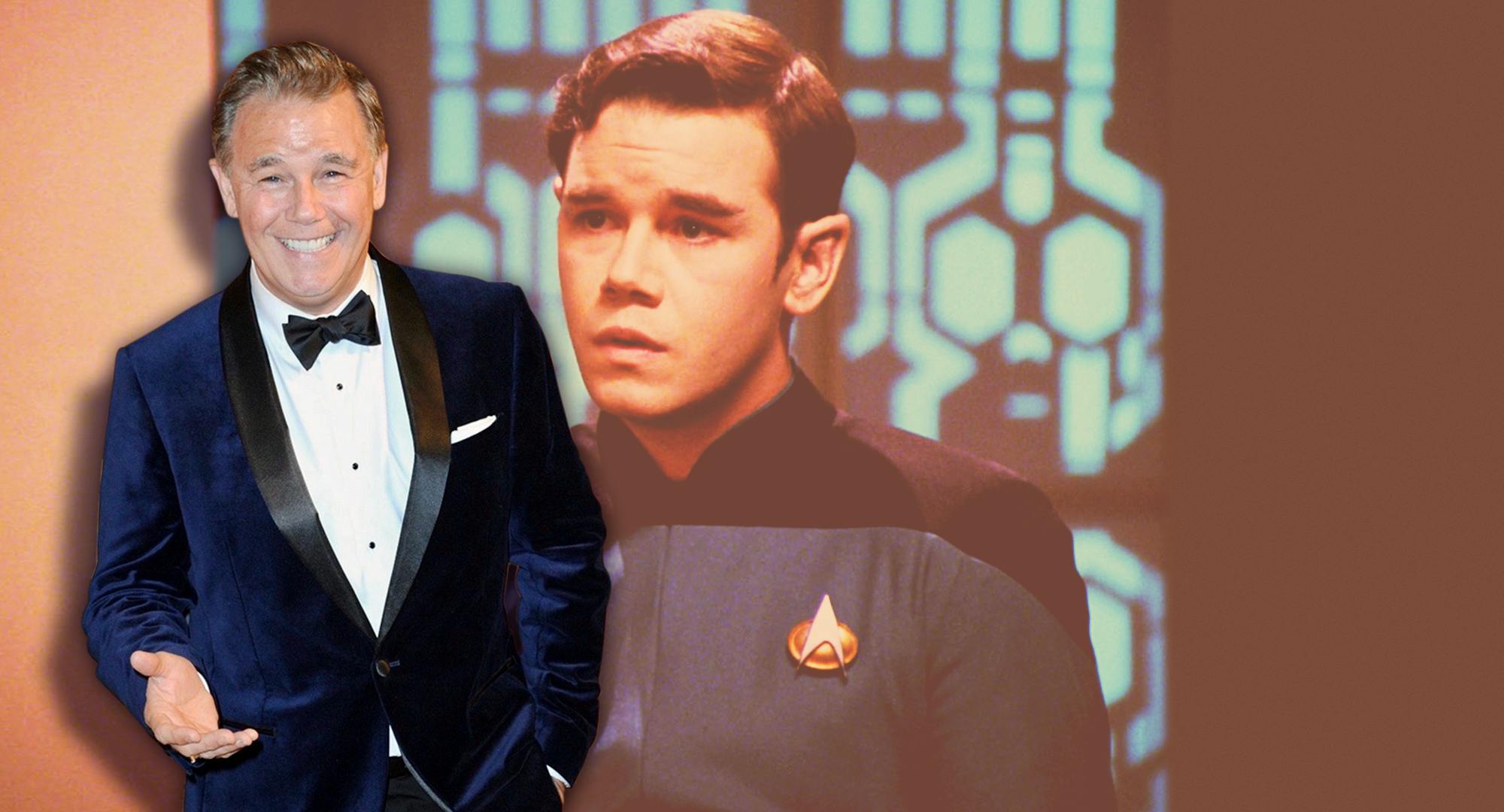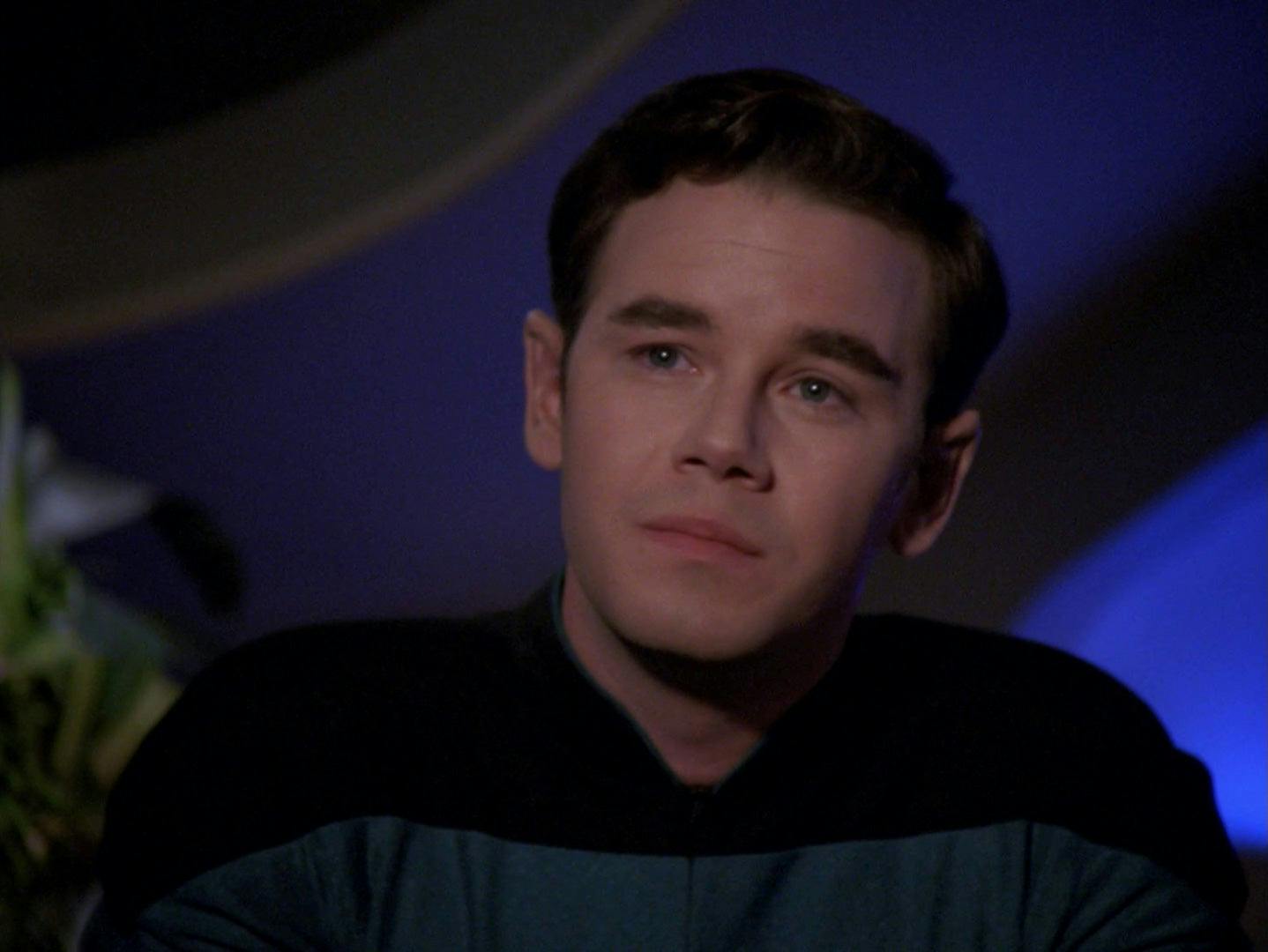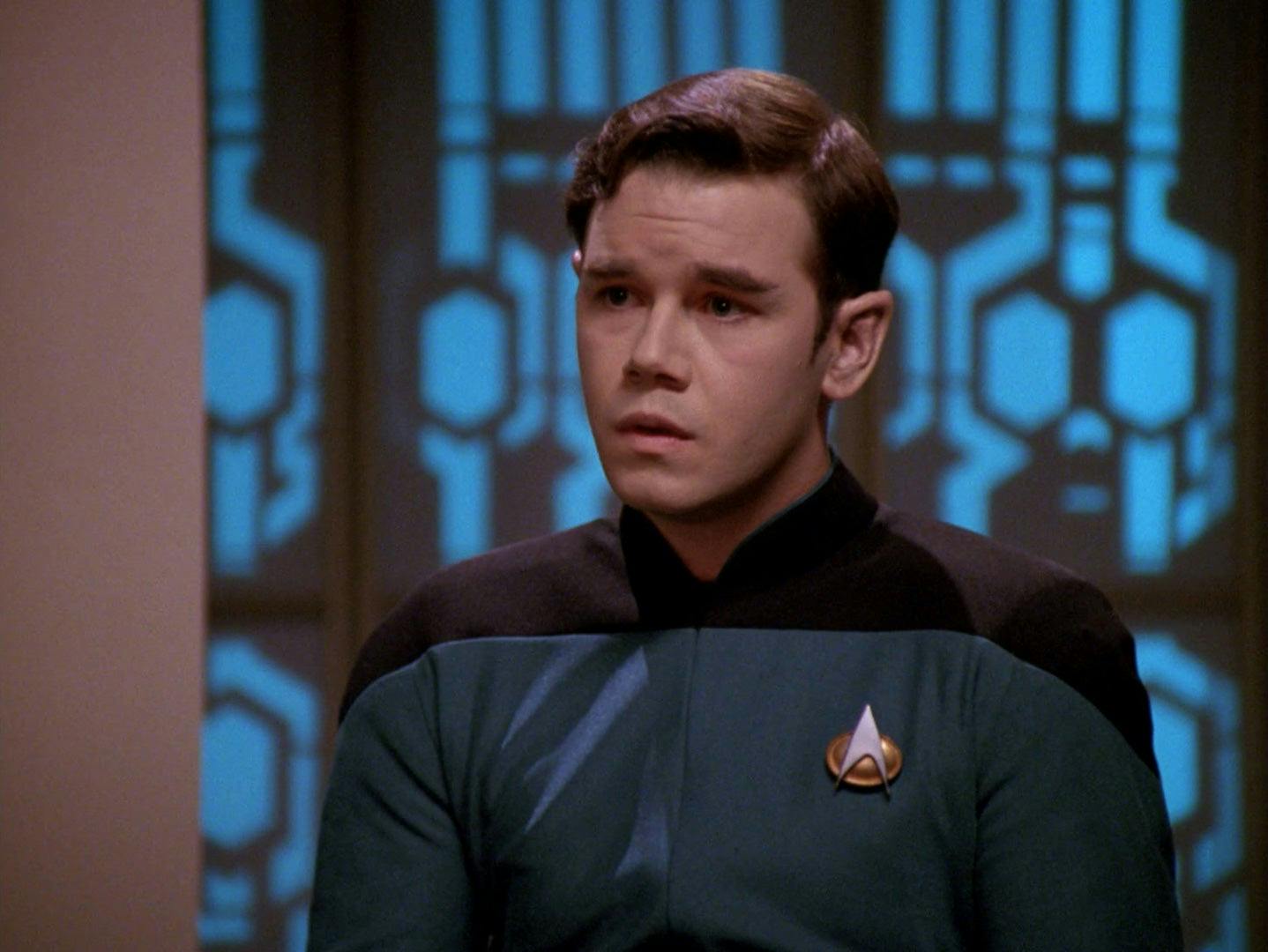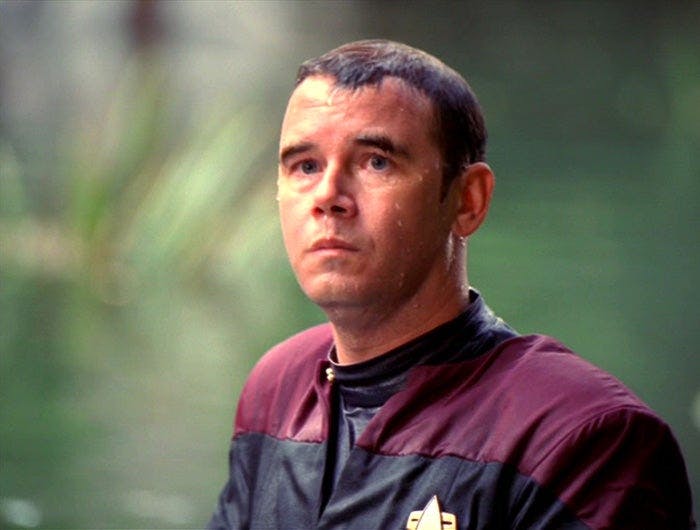Published Apr 24, 2021
Spencer Garrett Looks Back At The Drumhead
The actor tells us about being intimidated by Patrick Stewart, getting caught by the TNG cast at his day job, and trying to figure what the heck a Romulan was before YouTube existed.

StarTrek.com | ShutterStock/Eugene Powers
You’ve seen Spencer Garrett in dozens upon dozens of TV shows as well as in big movies like Air Force One and Once Upon a Time... in Hollywood. Back in 1991, he was a young, green actor who landed the plum role of crewman Simon Tarses in the Star Trek: The Next Generation episode “The Drumhead,” directed by Jonathan Frakes.
Written by Jeri Taylor based on a story by Ronald D. Moore, “The Drumhead” — which celebrates its 29th anniversary this month — took the persecution of the Salem witch trials and 1950s McCarthyism and put it in a 24th-century setting. Originally intended as a money-saving “bottle episode,” it became a TNG favorite, and a must-see episode for fans prepping for the Star Trek: Picard premiere.

StarTrek.com
We spoke to Garrett about playing Tarses in “The Drumhead,” Weiss in Voyager’s “Flesh and Blood,” and the friendships he formed with the TNG cast.
StarTrek.com: What did you know about Star Trek before you got the role?
Spencer Garrett: My only knowledge of it was that my godfather, an actor named Liam Sullivan, was on the original show. On TOS, he was on an episode called “Plato’s Stepchildren.” Do you know that one?
I know all of them, so yes. [Laughs]
SG: When I was cast, he dug out an old VHS copy of his episode, and I put it in my VHS player and I watched it, and that was probably the first time that I had seen any episode of Star Trek since I was a little kid. I was like, “Wow, this is a cool show.”
So how did you prepare for the role?
SG: I was trying to do as much research as I [could]. I mean, what is a Romulan? What does a Romulan act like? I had no clue. There was no YouTube back then; I was trying to find reruns of TOS, and started watching Next Generation to try to get the vibe and the tone of the show. I was asking friends of mine, Martha Lee, my cousin, “What’s a Romulan? How is a Romulan different from a Vulcan?”
I was all of the sudden in this completely foreign world. And I think it was the scene in the trial, where I’m being interrogated by Bruce French, the actor who was representing Jean Simmons’ character, and I started crying, in the scene. And we ended up having to go back and re-shoot that scene because Rick Berman, the exec producer, said, “No, a Romulan would never cry. He would be emotionless.” So we went back and re-shot that scene without me crying.
What was the atmosphere like on set while you were filming?
SG: It was great! I’m sitting next to Michael Dorn as he’s getting his head put on, they’re gluing his face on. Patrick’s to my right, and Jean Simmons, and — I mean, you’ve got to remember, this is really one of my first jobs with a significant role as a guest actor in a TV series, I hadn’t really done a heck of a lot before that. I was kind of like a kid in a candy store.
I remember the vibe being very welcoming. And I was treated like a veteran.

StarTrek.com
What was it like working with the cast?
SG: Doing those scenes with Patrick in his quarters... I remember being a little intimidated, and a little scared. And Jonathan Frakes, it might have been one of his earliest directing gigs, he was so gentle and loving, and just really wonderful with me. He’s, coincidentally, one of my favorite directors to act for ever since we did that episode because he just loves actors... being one himself and having been a very successful actor even before Star Trek, we just had a great rapport and a great vibe.
When I got cast, and I heard that Jean Simmons was going to be in the episode, I expected to see the guy from KISS when I walked into the makeup trailer. I was like, “The guy with the tongue from KISS, what a trip! I wonder what alien he’s gonna be playing!”
And then I walk in, and it’s J-E-A-N Simmons, from Guys and Dolls, and Spartacus. And she was probably in her late 50s, early 60s (and of course she was iconic to me even then, ‘cause I’ve been a movie junkie my entire life) and this gorgeous woman, who I’d known from her early films, had a mouth like a sailor. [I was] instantly crazy about her, because this gorgeous, genteel English actress, and she’s talking like a truck driver. We had a lot of fun together.
She was so chilling and scary in those scenes with me in the trial. But she was wonderful. It was a great experience.
What did you think of the final episode?
SG: I love the episode. I love what it was saying, first of all. I loved the writing. My interpretation of it at the time was “this is very much a metaphor for what’s going on with AIDS in the world right now.” The writing was wonderfully subversive and slyly political in its way.
That’s an interpretation I haven’t heard. When people talk about this episode, most of them focus on civil liberties and to McCarthyism. I’d love to get more specific about how it connected to the AIDS crisis for you.
SG: When Picard came to my defense, essentially his defense of me was, “Let’s not denigrate this man, let’s not convict him because he has tainted blood.” That was my takeaway in terms of the AIDS crisis. I mean there’s definitely a McCarthy-ist vibe that flows underneath all of it. You can interpret it that way as well.

StarTrek.com
To me, it was about me having tainted blood, and me being “the other” and me being ostracized because I had this otherness about me. And you could see Jean Simmons as a McCarthy character. Or even a Reagan-like character, if you want to get that deep with it.
I was very much involved with several AIDS relief projects back then, and I remember the script speaking strongly to me when I read it. I was aware of what the writers were trying to do.
Did getting that role on such a big show change your career at the time?
SG: Not really. I got the job, and then there was sort of a lull. I worked a little bit here and there, but I was still catering, and waiting tables, doing what I could to make ends meet. I got a job working at a restaurant in Silver Lake in L.A., which at the time, wasn’t really the bustling hipster place that it is now. I thought, If I’m going to wait tables, work at a restaurant, I’m going to take a gig at a place that’s not trafficked by people in my industry.
The very first night I worked there — I’m not kidding, the first night I worked there on the floor as the maître d, in walks Frakes, LeVar, Brent Spiner, Whoopi Goldberg, and Michael Dorn. They had a jazz night at this restaurant, and these guys came in on a regular basis — they played there every Thursday night. I think Frakes played the trombone, Spiner played the piano, Whoopi came to watch, they all hung together. So they walked in the door, and they saw Simon Tarses there as the maître d, and I thought, “Well this is fucking humbling.”
That’s hilarious! How was their performance?
SG: They were terrific! They came in every Thursday night. And they all became [my] friends. I knew after we did the episode that Jonathan and I would have a rapport that would last beyond that, but I became friends with Brent and Whoopi; we’ve all worked together at various points over the years as well.
But it was just so strange to see them come in there: I mean, oh God, I picked this restaurant where I can get away from all the Hollywood types, and in walks the cast of the show that I had just worked on.
Let’s talk about Voyager! How did you get cast in “Flesh and Blood”?
SG: I’d always wondered if they were going to bring Tarses back in some other iteration. I was jonesing to do another one. I would run into Rick Berman or Ken Biller or Brannon Braga — who’s a neighbor of mine, still lives around the corner from me — and every time I would see them, it would be like, “Yeah, we’re gonna get you back here somehow.”
Ken Biller, who was showrunning Voyager, said, “I’ve got a role for you. It’s not Simon Tarses. You’re going to come back as a hologram. But it’s a terrific part. You get to carry a gun, and emerge out of this murky swamp.” I said, “I’m in.”
At that point, nine years later, I had become a full-on fan. I’d seen every episode of TNG, and every episode of Voyager, and every episode of Deep Space Nine, so I was psyched to play the character in Voyager.
I was living in an apartment literally right across the street from Paramount Studios, so I would walk out my front door and walk across the street onto the Paramount lot. And there was not a lot of makeup involved in that! So it was a pretty easy gig.
I remember that when we broke for lunch, instead of eating the catered lunch food, I would run back to my apartment across the street and grab a nap in my own bed.
In your uniform?
SG: Sure! I’d throw a sweater on, over my spandex — my polyester uniform. I still have my badge.I swiped a couple of things. I’ve got three or four pairs of ears [from “The Drumhead”], which are kind of worse for wear now, and I have a couple of badges that were velcro’d to my suit. I remember saying to the costume person at the time, “Can I have one of these?” And he just said, “I’m gonna look the other way. I didn’t see anything.”

StarTrek.com
Standing waist-deep in that swamp, what was that like? You had to rise up out of it.
SG: Over and over and over and over again. We shot that swamp scene on the Warner Brothers lot, and it was freezing cold. There were three or four of us in the water, and I had to keep going down under water. It was just so bloody cold, I forget what time of the year it was, but probably six o’clock in the morning. They don’t heat that water, and it was just nasty. The water was murky, and god knows what all crap was in there. [Laughs] I just remember scrubbing myself down hard at the end of that two days of filming.
I remember thinking at the time, “I’m gonna get sick.” And I did. I got sick from the cold water, and whatever germs were in that swamp.
Your scenes were separate from most of the rest of the cast, did you get to spend any time with them?
SG: I don’t think so. I knew Robbie McNeill a little bit, but we didn’t have any stuff together. When he got Voyager, I was doing a show that nobody had ever heard of called Hitz, with Andrew Dice Clay. Robbie and I met at the Upfronts in New York, for our respective shows. He was there with Kate Mulgrew, you know, this very sophisticated bunch of actors, and I’m there with Andrew Dice Clay (laughs), and this motley bunch for this really bawdy wonderful/awful sitcom that lasted one season, and I remember turning to Robbie and I said, “You’re gonna be on this ride for a long time, well beyond this, you know that.” And he was like, “Oh, I know.”
He’s also a terrific director. Actors love working with Robbie much the same way they love working with Johnny Frakes.
How would you say has Star Trek fandom affected you?
SG: Years later, when I started to get some recognition for some work that I had been doing over the years, the first thing that people would say is, “You’re Simon Tarses, from ‘The Drumhead’.” It was always shocking to me; I’d racked up a pretty good body of work at that point, and every time, to a person, everyone would say “Simon Tarses from ‘The Drumhead’.” So that’s when I realized Oh my god, this thing has a footprint.
And when I went to the first convention a couple years ago, the reaction to me being there was so lovely. People came to me and said, “We’ve always wondered when you were going to show up at one of these things, what took you so long?” The fandom of Star Trek, the fact that it has endured this long and that it’s so strong… it’s such an extraordinary community. It’s a very cool thing to be a part of.
We talked a bit our mutual love of the show Better Things, and the conversation found its way into this fun story about several actors who, like Spencer, had also appeared on one Star Trek or another.
SG: Speaking of character actors, there’s a group of us that meets for dinner every Sunday night, once a month, the last two years. And we call ourselves “the CADS,” it’s the Character Actors Dining Society. It’s me, Steven Weber…
He was on Star Trek.
SG: Yes, also on Star Trek! Richard Kind—probably not on Star Trek, Alfred Molina, Kevin Pollack, LeVar is part of it, Laurence Fishburne. Titus Welliver who’s on the show Bosch [and was on Voyager.] Danny DeVito has joined us. Oh, and Michael McKean is a part of it.
Michael was also on Star Trek.
SG: Was he really?
You have to see his Voyager episode. It is the creepiest… he is unbelievable in it. He’s the centerpiece of the whole episode and rightfully so.
SG: He’s a phenomenal actor.
Last month, I was in Chicago doing Chicago PD, and I couldn’t make it. So all these guys are dining, and it’s LeVar, and Alfred Molina, and Weber, and Richard Kind, and Kevin Pollack, and McKean, and maybe a few others, and they were here at a restaurant in L.A. And Patrick Stewart showed up. He was having dinner at the next table, and he’s like [in a pretty good Patrick Stewart impression], “Well look at this motley crew.” And he came over and joined them. I was so bummed. I would’ve just freaked if I saw him.
(The CADS say thank you to health care workers)
So, what do you have coming up that you’re excited about? You’ve had a pretty good year.
SG: Yeah, I had a fun year last year. I did the Tarantino film Once Upon a Time... in Hollywood, I did Bombshell.
Had you worked with Quentin Tarantino before?
SG: I had not. That was a treat. We shot that entire scene in about an hour, just me and the two guys [Brad Pitt and Leonardo DiCaprio]. And when the movie was coming out last summer, I was standing in line waiting to get a table in a restaurant and there was a tap on my shoulder, and I turned around, and I said, “Oh hi, Leonardo DiCaprio.” ‘Cause you know, you don’t see that every day. And he said, “Dude, I just saw the trailer, it’s coming out tomorrow.” He said, “And you’re in the trailer.” And I said, “Oh that’s great, I’m happy to know that.” And he’s like, “No no, you are the trailer.” And the trailer came out the next day and I was all over the thing.
I had a podcast called America 2.0 with Laurence Fishburne and Kate Walsh, and Patrick Adams from Suits that became the number one podcast in the country last year. It’s a political drama, like The West Wing. We’re developing that into a television show right now.
That’s amazing.
SG: Yeah, pretty exciting stuff. And Fishburne is on board. I mean, god knows when everything is going to get moving again. Everything’s shut down.
And the most exciting thing that I’m looking forward to is an HBO series called Showtime. It’s about the early 1980s L.A. Lakers, with Magic Johnson and Kareem Abdul-Jabbar, and Pat Riley and that whole gang. And I play Chick Hearn, he was the broadcaster for the Lakers for fifty years. We were supposed to start filming our ten episodes at the end of this month, and that’s been shut down. Whenever life gets back to normal, we’re going to go into production on that.
So, some fun irons in the fire when the more important fire in this world is hopefully extinguished.
This interview has been edited and condensed. You can check out Spencer's coronavirus fundraiser show, Quarantine The Show, on InstagramTV where he is raising money for the SAG/AFTRA Foundation's COVID-19 relief fund helping actors in need.
Laurie Ulster (she/her) is a freelance writer and a TV producer who somehow survived her very confusing adolescence as the lone female Star Trek fan in middle school. She's a writer/editor and was the Supervising Producer on After Trek.

